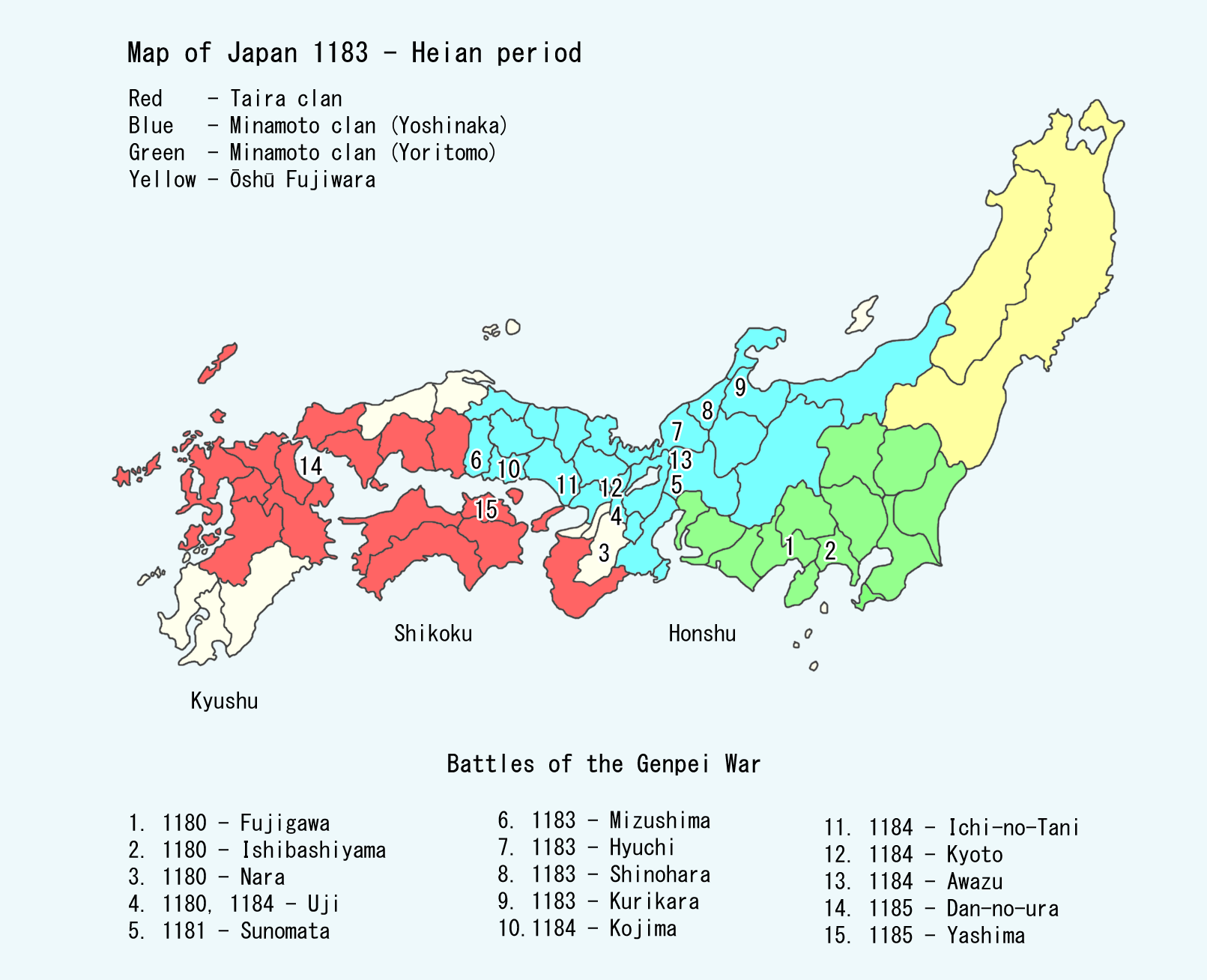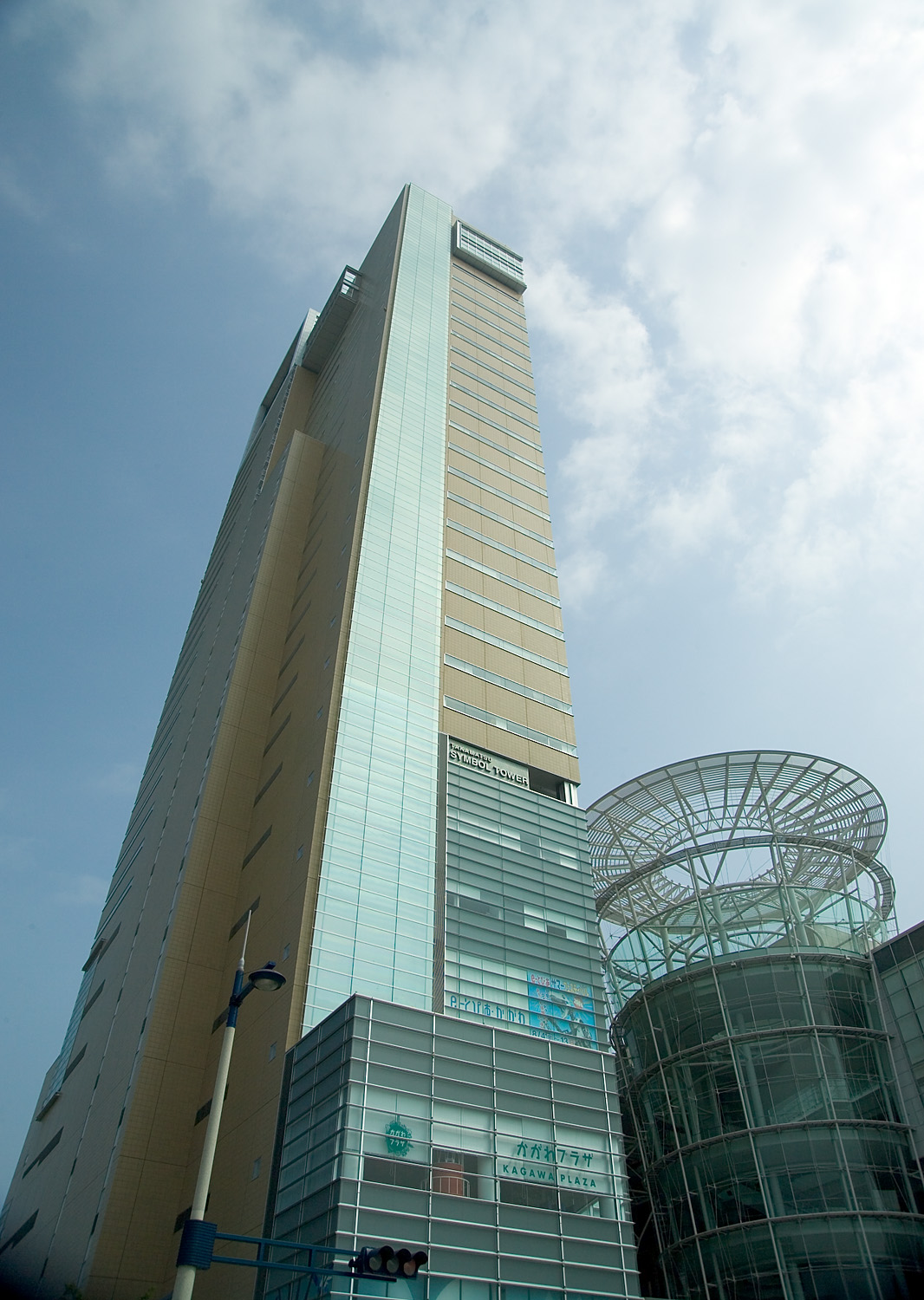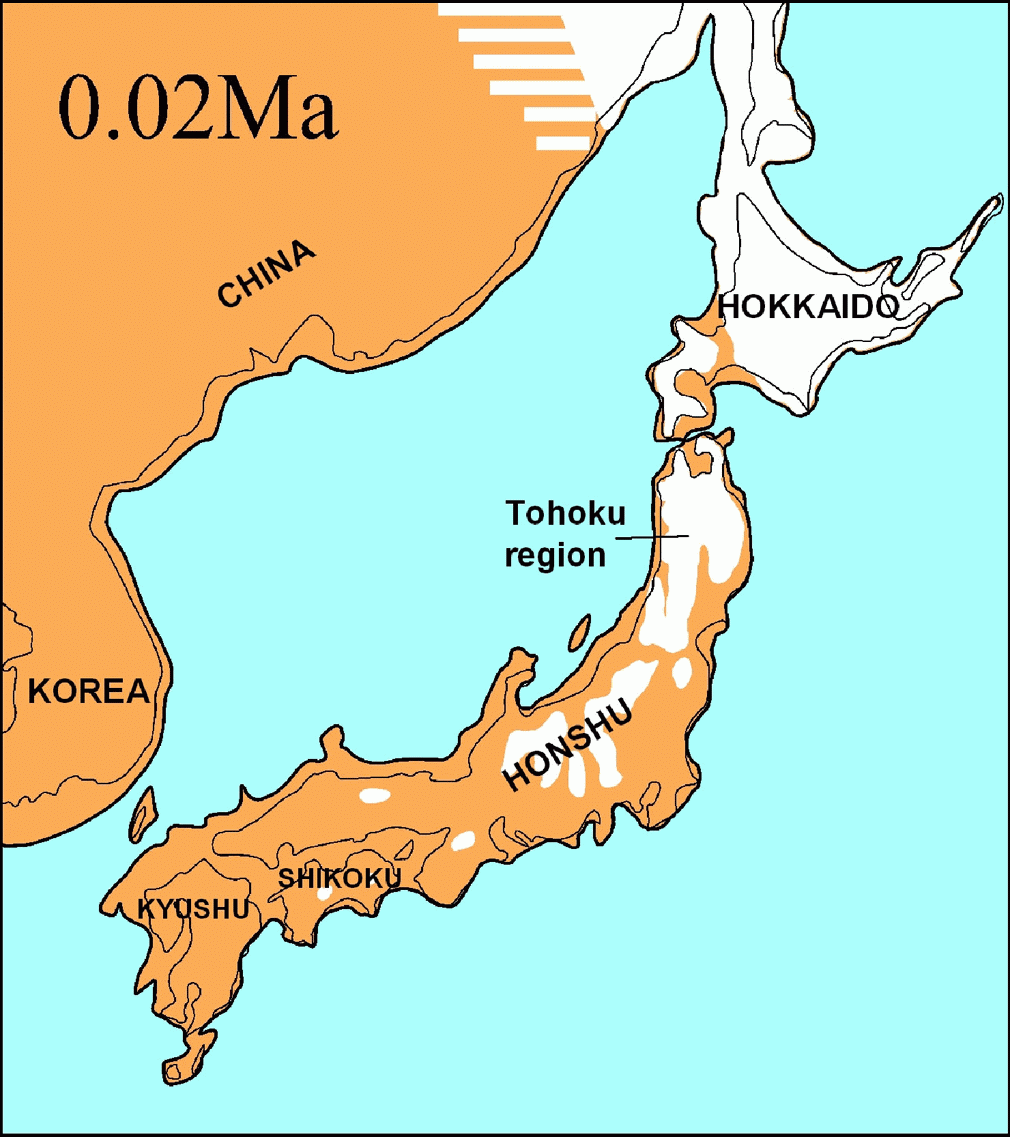|
Battle Of Kojima
The Battle of Kojima (児島合戦), also called Battle of Fujito (藤戸の戦い), was a battle of the Genpei War of the Heian period of Japanese history, and took place in 1184. Battle In pursuit of the fleeing Taira from Ichi-no-Tani, on their way to Yashima, Minamoto no Noriyori engaged and defeated his enemies in battle at Kojima. The attack was led by Sasaki Moritsuna, who swam his horse across a narrow strait between Kojima and the mainland of Honshū , historically known as , is the largest of the four main islands of Japan. It lies between the Pacific Ocean (east) and the Sea of Japan (west). It is the seventh-largest island in the world, and the second-most populous after the Indonesian .... See also * '' The Tale of Heike'' References Battles of the Genpei War 1180s in Japan 1184 in Asia Conflicts in 1184 Military history of Okayama Prefecture {{Japan-battle-stub ... [...More Info...] [...Related Items...] OR: [Wikipedia] [Google] [Baidu] |
Genpei War
The was a national civil war between the Taira clan, Taira and Minamoto clan, Minamoto clans during the late Heian period of Japan. It resulted in the downfall of the Taira and the establishment of the Kamakura shogunate under Minamoto no Yoritomo, who appointed himself as ''Shōgun'' in 1192, governing Japan as a military dictator from the eastern city of Kamakura. It followed a ''coup d'état'' by the Taira in 1179 with the removal of rivals from all government posts, and subsequently banishing them, and a call to arms against the Taira, led by the Minamoto in 1180. The ensuing Battle of Uji (1180), Battle of Uji took place just outside Kyoto, starting a five-year-long war, concluding with a decisive Minamoto victory in the naval Battle of Dan-no-ura. However, it has been pointed out that the Battle of Ōshū in 1189 was the last battle during this period of civil war, as it completed Yoritomo's nationwide domination through the annexation of Tōhoku region, Northeast Japan. ... [...More Info...] [...Related Items...] OR: [Wikipedia] [Google] [Baidu] |
Taira
The was one of the four most important clans that dominated Japanese politics during the Heian period of Japanese history – the others being the Minamoto, the Fujiwara, and the Tachibana. The clan is divided into four major groups, named after the emperors they descended from: Kanmu Heishi, Ninmyō Heishi, Montoku Heishi, and Kōkō Heishi, the most influential of which was the Kanmu Heishi line. In the twilight of the Heian period, the Taira controlled the boy emperor Antoku (himself the grandson of the powerful ''Kugyō'' Taira no Kiyomori) and had effectively dominated the Imperial capital of Heian. However, they were opposed by their rivals the Minamoto clan (the Genji), which culminated in the Genpei War (1180–1185 AD). The five-year-long war concluded with a decisive Taira defeat in the naval Battle of Dan-no-Ura, which resulted in the deaths of Antoku and Taira leaders. Following the war, the victorious Minamoto established Japan's first shogunate in Kamaku ... [...More Info...] [...Related Items...] OR: [Wikipedia] [Google] [Baidu] |
1184 In Asia
Year 1184 ( MCLXXXIV) was a leap year starting on Sunday of the Julian calendar. Events By place Europe * March 27 – Tamar of Georgia becomes queen regnant on the death of her father and coregent George III. She remains sole ruler of Georgia (the first woman to hold this office) until her death in 1213. * May 20 – Diet of Pentecost: Emperor Frederick Barbarossa, Holy Roman Emperor, organises a conference in Mainz. During the diet Frederick negotiates with Henry the Lion about an anti-French alliance with England. * June 15 – Battle of Fimreite: King Sverre of Norway defeats and kills his rival, Magnus V (Erlingsson) near Fimreite. Sverre takes the throne and becomes sole ruler of Norway (until 1202). * July 26 – Approximately 60 are killed in the Erfurt latrine disaster. * Summer – Almohad forces reconquer the Alentejo (except for Évora), and besiege Lisbon on land and blockade the port with their navy. A Portuguese soldier manages ... [...More Info...] [...Related Items...] OR: [Wikipedia] [Google] [Baidu] |
1180s In Japan , synthetic chemical element with atomic number 118
{{Numberdis ...
118 may refer to: *118 (number) *AD 118 *118 BC *118 (TV series) *118 (film) *118 (Tees) Corps Engineer Regiment *118 (Tees) Field Squadron, Royal Engineers *118 Peitho, a main-belt asteroid See also *11/8 (other) *Oganesson Oganesson is a synthetic element, synthetic chemical element; it has Chemical symbol, symbol Og and atomic number 118. It was first synthesized in 2002 at the Joint Institute for Nuclear Research (JINR) in Dubna, near Moscow, Russia, by a joint ... [...More Info...] [...Related Items...] OR: [Wikipedia] [Google] [Baidu] |
Battles Of The Genpei War
A battle is an occurrence of combat in warfare between opposing military units of any number or size. A war usually consists of multiple battles. In general, a battle is a military engagement that is well defined in duration, area, and force commitment. An engagement with only limited commitment between the forces and without decisive results is sometimes called a skirmish. The word "battle" can also be used infrequently to refer to an entire operational campaign, although this usage greatly diverges from its conventional or customary meaning. Generally, the word "battle" is used for such campaigns if referring to a protracted combat encounter in which either one or both of the combatants had the same methods, resources, and strategic objectives throughout the encounter. Some prominent examples of this would be the Battle of the Atlantic, Battle of Britain, and the Battle of France, all in World War II. Wars and military campaigns are guided by military strategy, whereas batt ... [...More Info...] [...Related Items...] OR: [Wikipedia] [Google] [Baidu] |
The Tale Of The Heike
is an epic account compiled prior to 1330 of the struggle between the Taira clan and Minamoto clan for control of Japan at the end of the 12th century in the Genpei War (1180–1185). It has been translated into English at least five times. The first translation was by Arthur Lindsay Sadler, in 1918–1921. A complete translation in nearly 800 pages by Hiroshi Kitagawa & Bruce T. Tsuchida was published in 1975. It was also translated by Helen McCullough in 1988. An abridged translation by Burton Watson was published in 2006. In 2012, Royall Tyler completed his translation, which, he says, seeks to be mindful of the performance style for which the work was originally intended. Historical novelist Eiji Yoshikawa published a prose rendering in the '' Asahi Weekly'' in 1950, under the title ' (''Shin Heike Monogatari''). Background Title Heike () refers to the Taira (), ''hei'' being the ''on'yomi'' reading of the first ''kanji'' and "ke" () meaning "family". However, in t ... [...More Info...] [...Related Items...] OR: [Wikipedia] [Google] [Baidu] |
Honshū
, historically known as , is the largest of the four main islands of Japan. It lies between the Pacific Ocean (east) and the Sea of Japan (west). It is the seventh-largest island in the world, and the second-most populous after the Indonesian island of Java. Honshu had a population of 104 million , constituting 81.3% of the entire population of Japan, and mostly concentrated in the coastal areas and plains. Approximately 30% of the total population resides in the Greater Tokyo Area on the Kantō Plain. As the historical center of Japanese cultural and political power, the island includes several past Japanese capitals, including Kyōto, Nara, and Kamakura. Much of the island's southern shore forms part of the Taiheiyō Belt, a megalopolis that spans several of the Japanese islands. Honshu also contains Japan's highest mountain, Mount Fuji, and its largest lake, Lake Biwa. Most of Japan's industry is located in a belt running along Honshu's southern coast, from Tokyo to N ... [...More Info...] [...Related Items...] OR: [Wikipedia] [Google] [Baidu] |
Kojima District, Okayama
is a district located in Okayama Prefecture, Japan. As of 2003, the district had an estimated population of 15,872 and a density of 514.32 persons per km2. The total area was 30.86 km2. On March 22, 2005 - the town of Nadasaki, along with the town of Mitsu (from Mitsu District), was merged into the expanded city of Okayama is the prefectural capital, capital Cities of Japan, city of Okayama Prefecture in the Chūgoku region of Japan. The Okayama metropolitan area, centered around the city, has the largest urban employment zone in the Chugoku region of western J .... See also * Nadasaki, Okayama References Former districts of Okayama Prefecture {{Okayama-geo-stub ... [...More Info...] [...Related Items...] OR: [Wikipedia] [Google] [Baidu] |
Takamatsu, Kagawa
270px, Takamatsu City Hall 270px, Aerial view of Takamatsu city center 270px, View from Yashima to Takashima port is a capital city located in Kagawa Prefecture, Japan. , the city had an estimated population of 414,134 in 190,120 households and a population density of 1,100 persons per km2. The total area of the city is . It is the capital city of the prefecture. Geography Takamatsu is located in central Kagawa Prefecture on the island of Shikoku. The city is located in the Takamatsu Plain, which is part of the Sanuki Plain, and is occupied by a gentle slope as a whole. The northern part faces the Seto Inland Sea, forming a semicircular urban area centered on Takamatsu Port and Takamatsu New Port (commonly known as Shinminato).The western part of the city consists of an alluvial fan formed by the sedimentation of the Koto River. The eastern part is a flooded plain formed by the Kasuga River and Shinkawa River. In the northeastern part of the island, there is Yashima, a table- ... [...More Info...] [...Related Items...] OR: [Wikipedia] [Google] [Baidu] |
Battle Of Ichi-no-Tani
The was fought between the attacking Minamoto clan and the defending Taira clan at Suma, to the west of present-day Kobe, Japan, on 20 March 1184. It sat on a very narrow strip of shore, between mountains on the north, and the sea to the south. This made it quite defensible, but also made it difficult to maneuver troops inside the fortress. The Taira suffered a crucial defeat to the forces of Minamoto no Yoshitsune and Minamoto no Noriyori. Battle Minamoto no Yoshitsune split his forces in two. Minamoto no Noriyori's forces attacked the Taira clan at Ikuta Shrine, in the woods a short distance to the east. A second detachment, no more than a hundred horsemen under Yoshitsune himself, attacked the Taira at Ichi-no-Tani from the mountain ridge to the north. At the chosen hour, the Minamoto forces attacked causing confusion among the Taira who neither deployed nor retreated. Only about 3,000 Taira escaped to Yashima, while Tadanori was killed and Shigehira captured. Also ki ... [...More Info...] [...Related Items...] OR: [Wikipedia] [Google] [Baidu] |
Japanese History
The first human inhabitants of the Japanese archipelago have been traced to the Paleolithic, around 38–39,000 years ago. The Jōmon period, named after its cord-marked pottery, was followed by the Yayoi period in the first millennium BC when new inventions were introduced from Asia. During this period, the first known written reference to Japan was recorded in the Chinese ''Book of Han'' in the first century AD. Around the 3rd century BC, the Yayoi people from the continent immigrated to the Japanese archipelago and introduced iron technology and agricultural civilization. Because they had an agricultural civilization, the population of the Yayoi began to grow rapidly and ultimately overwhelmed the Jōmon people, natives of the Japanese archipelago who were hunter-gatherers. Between the fourth and ninth centuries, Japan's many kingdoms and tribes gradually came to be unified under a centralized government, nominally controlled by the Emperor of Japan. The imperial dynasty es ... [...More Info...] [...Related Items...] OR: [Wikipedia] [Google] [Baidu] |
Ukiyo-e
is a genre of Japanese art that flourished from the 17th through 19th centuries. Its artists produced woodblock printing, woodblock prints and Nikuhitsu-ga, paintings of such subjects as female beauties; kabuki actors and sumo wrestlers; scenes from history and folk tales; travel scenes and landscapes; Flora of Japan, flora and Wildlife of Japan#Fauna, fauna; and Shunga, erotica. In 1603, the city of Edo (Tokyo), Edo (Tokyo) became the seat of the ruling Tokugawa shogunate. The class (merchants, craftsmen and workers), positioned at the bottom of Four occupations, the social order, benefited the most from the city's rapid economic growth. They began to indulge in and patronize the entertainment of kabuki theatre, geisha, and oiran, courtesans of the Yūkaku, pleasure districts. The term ('floating world') came to describe this hedonistic lifestyle. Printed or painted ukiyo-e works were popular with the class, who had become wealthy enough to afford to decorate their homes wit ... [...More Info...] [...Related Items...] OR: [Wikipedia] [Google] [Baidu] |







